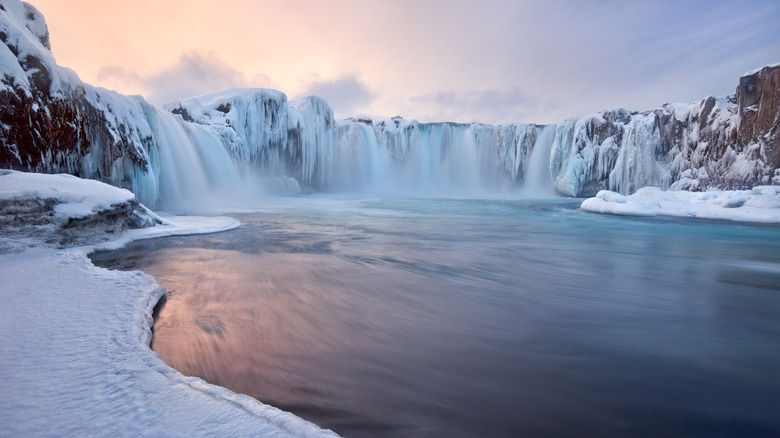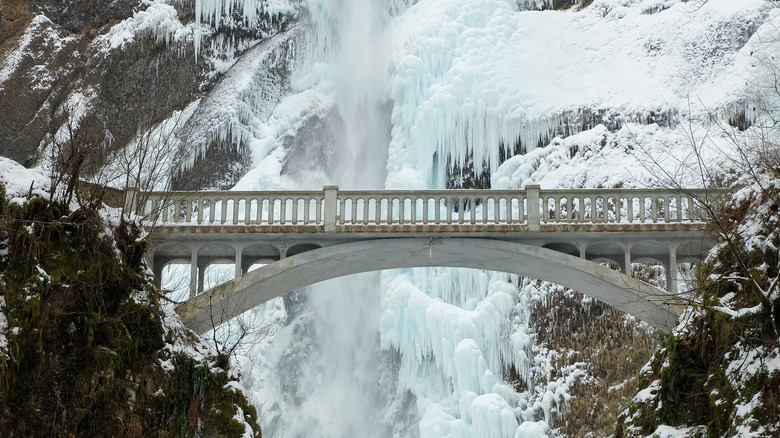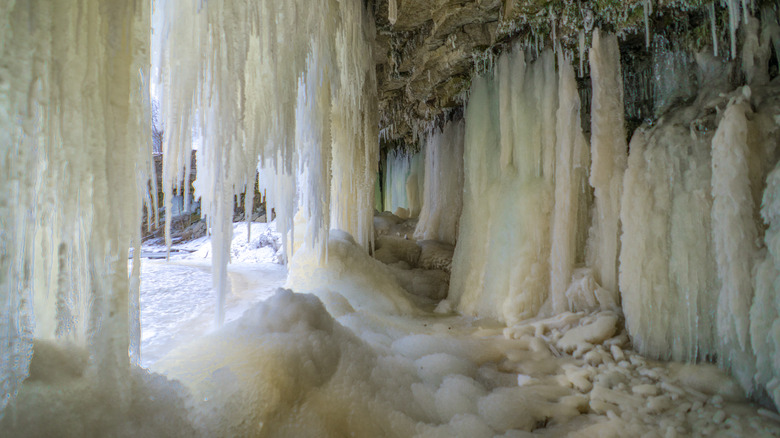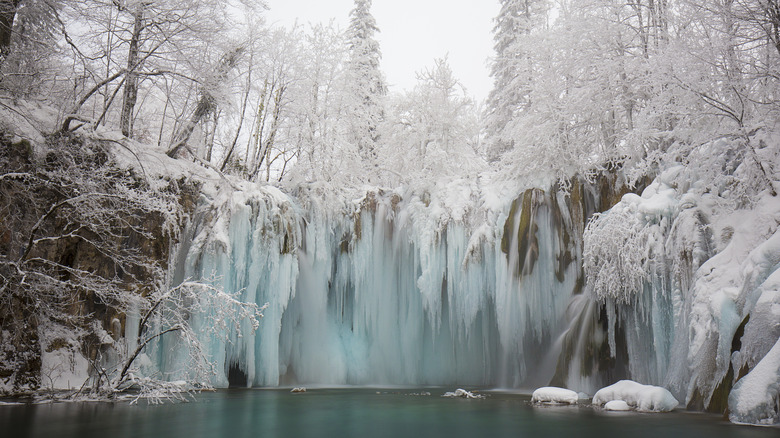Few things make us want to follow a trail to its end more than waterfalls. Couple the wonder of hiking up to a cascade of water, wreathed in rainbows, with the magic of a fresh snowfall, and you might just convince us to make a trek or two in the dead of winter. Frozen waterfalls are a rare phenomenon worth the sweat and can occur anywhere temperatures dip below freezing.
We’ve determined our list of the world’s best frozen waterfalls through first-hand accounts from avid hikers, official tourism sites, and some Google sleuthing of our own. Sorry, TLC, these frozen torrents of ice and snow are certainly worth chasing! From a waterfall that could only be born from Québec’s sub-zero temperatures to an ethereal turquoise frozen wonder near one of the snowiest cities in the world, these are some of the best frozen waterfalls on Earth. Grab your crampons and a thermos of cocoa, and come with us to a winter wonderland.
Plitvice Lakes National Park, Croatia

As one of the most beautiful destinations in Croatia, usually visited in the summer months, Plitvice Lakes National Park becomes a winter wonderland by the time January rolls around. The trickling falls slowly freeze in particularly cold winters, creating a Narnia-esque landscape. Mix this snowy scenery with the turquoise water of Plitvice’s 16 different lakes, and you have something that is truly straight out of a fairytale.
While most of the park remains open in winter, allowing visitors to navigate snowy pathways that hover above frozen lakes and through the flocked trees, some parts do close. There are multiple options for visitors to see frozen waterfalls in Plitvice. Head out to Veliki Slap, also known as the Great Waterfall, for a chance to see its torrents of water encased in ice. Another, and even more scenic, option is to sail out on Lake Kozjak for a chance to see the upper lake and its frozen cascades. Setting out on the boat across the water makes for a memorable experience made even better by the wintry landscape.
Multiple buses run daily between Plitvice and Zagreb and also stop and take off from nearby towns. You can also choose to hop on a tour out to the national park, although many don’t run in the winter months. Overall, your best bet for exploring is by car.
Niagara Falls, New York

While Niagara Falls never truly freezes, a combination of mist and spray often solidifies into a shell that appears as if the falls have frozen over. Coupled with the torrents of water that still stream beneath its icy surface and a chilled wreath of trees, this wintry phenomenon creates an otherworldly landscape that looks as though it were frozen in time. In winter, this area of New York sees frigid temperatures and lake-effect snow that can bury the surrounding cities and forests in feet upon feet of powder.
The Goat Island Trail is one of the best ways to experience the “frozen” falls — and to glimpse chunks of ice floating down the Niagara River. This 1.8-mile loop trail is accessed via a bridge and can potentially close in winter due to snowy conditions. Hikers lucky enough to hit the trail can thaw out with a hot chocolate or steaming cup of coffee at SPoT Coffee, which is situated along the trail.
Visitors can turn their hiking up a notch by popping into the Cave of the Winds Pavilion to grab a pair of snowshoes for better hiking traction. The snowshoes are rented out for free from 10 a.m. to 2:30 p.m. This is one of the most magical ways to experience Niagara Falls in the winter months — and makes for a memorable mode of transportation.
Apostle Islands ice caves, Wisconsin

Bryan Neuswanger/Shutterstock
As the depths of winter descend on Wisconsin, the Great Lakes form massive walls of frozen waves and a thorny crown of icicles. These are the Apostle Islands ice caves, a winter phenomenon that rarely occurs but, when it does, leaves visitors breathless with wintry delight. Half of the adventure in reaching the ice caves comes from the 1.1-mile hike across frozen Lake Superior, crossing an otherwise tumultuous body of water completely encased in a thick layer of ice. While the sea caves can also be explored in summer, when water surrounds them completely, part of the magic is in hikers’ ability to walk around and explore these behemoths of stone and snow.
The ice caves of the Apostle Islands can be elusive because they require perfect conditions to create their frozen cascades. Lake Superior needs to be 90% frozen to maintain the ice caves long enough for visitors to explore, which hasn’t happened for years. National Park staff monitor the thickness of the ice on a daily basis. The ice must meet a rigorous set of rules and regulations before park rangers will declare that the caves are open to the public. Still, these incredible caves are worth pining for in the meantime.
Goðafoss, Iceland

Shcherbina Valeriy/Shutterstock
Iceland is the king when it comes to stunning waterfalls, so you’re bound to find some incredible frozen cascades in this Nordic destination come winter. Goðafoss is one of the largest waterfalls in Iceland by volume, its edges freezing into an impressive display of snow and ice by January and building up to look as though the waterfall is almost frozen. Because of the large amount of water that rushes over its edge, the waterfall never completely freezes but does look beautifully icy from December to March.
It takes just a 1.8-mile round-trip hike to reach Goðafoss from the parking lot along Iceland’s Ring Road near the town of Akureyri. A small platform allows for unbridled viewing of the falls and doubles as a popular place to watch the northern lights if they happen to make an appearance come nightfall. Be sure to bundle up and wear the appropriate footwear for your adventure, as the steps and pathways to reach the falls can become slippery with snow and ice.
Multnomah Falls, Oregon

Tobin Akehurst/Shutterstock
This hike might be a breeze, but the views will certainly make you feel like you’ve climbed a mountain to reach them. Multnomah Falls is a striking 620-foot waterfall in Oregon’s Columbia River Gorge. Near-perfect conditions are needed to see the falls freeze completely, but if they do, it’s a scene straight out of a fantasy world. The forecast needs to be well below freezing for days, if not weeks, on end to achieve this frozen waterfall. Good things come to those who wait, and these frozen falls are simply magnificent.
If you’re not able to witness Multnomah Falls in a frozen state, a fresh snowfall gracing the dense foliage that surrounds the waterfall creates an equally picturesque landscape to enjoy. Bonus: The falls see very few visitors in the winter months, which means there’s a good chance you might have this beautiful scenery all to yourself.
Montmorency Falls, Québec City

Dan Lamont/Shutterstock
Right in the heart of Québec City, Montmorency Falls is almost 100 feet higher than its cousin Niagara and freezes solid in the icy Québecois winters. While this waterfall is a powerful sight in summer, there’s something extra special about exploring Montmorency Falls in the winter months.
Visitors can see this wonder of solidified water from various viewing points on the Promenade a Bas de la Chute, the Observation Tower, or the Montmorency Falls Vista Point. Be warned that most hiking trails, like the one that connects all of these viewpoints, are closed off in winter, and there’s a chance you’ll have to drive between them.
For those not quite up for hiking around, hop on board the cable car for a bird’s eye view of the snow-covered falls. Montmorency Falls is also a popular ice climbing destination, and you might spot some dare-devil climbers if you’re lucky. The hot chocolate at nearby Chocolaterie de l’Ile d’Orleans is the best way to warm up after your winter adventures.
Minnehaha Falls, Minnesota

Wolterk/Getty Images
Minnehaha Falls is known for its towering icicles and frozen sheets of water that look as if they’re almost burbling at its base, icing up as early as December. The falls have been the topic of poems and a tourist destination since the 1800s, drawing in visitors who traveled along the Milwaukee Road. Today, the falls are a part of Minnehaha Regional Park on the edge of downtown Minneapolis.
Minneapolis is known for its icy-cold winters when extremely low temperatures help to freeze the falls solid. A quick 2.1-mile roundtrip hike allows visitors to access a viewing platform to see this natural phenomenon of snow and ice. Hikers will also catch a glimpse of the Mississippi River along the trail as Minnehaha Creek eventually makes its way to the river. Note that it is illegal to climb down to the falls or walk beyond the “Do Not Trespass” signage. This is for visitor safety, as the ice isn’t monitored. Ice can be pretty slippy, if you weren’t already aware.
Helmcken Falls, British Columbia

Harry Beugelink/Shutterstock
Helmcken Falls is a truly striking site to see in summer, but pair sub-zero temperatures with this 463-foot waterfall, and you have a match made in frosty heaven. This waterfall is too powerful to freeze completely, but it does create a magnificent ice cone that can grow to almost 165 feet high in record-setting cold. This makes an almost reverse waterfall effect that is rare to see and worth the hike if conditions are right. Your best chance to see this phenomenon is between the end of January and mid-February.
The 5.1-mile roundtrip Helmcken Falls Rim Trail is a fun way to reach this magical masterpiece of snow and ice. Unlike other trails in winter, this one doesn’t close due to inclement weather. Pack your crampons or snowshoes just in case, and take to the trail with a sturdy pair of hiking boots. If you’re not up for a long hike in winter weather, visitors can also simply drive up to a viewing platform right above the falls. Note that you might need snow chains to reach this remote location.
Korouoma Canyon, Finland

T. Miettinen/Shutterstock
Finland’s north isn’t just about Santa Claus and reindeer — it also holds frosty secrets like frozen waterfalls and snow-encrusted trees. Tucked away in Lapland, Finland’s unofficial capital of all things winter, the Korouoma Canyon has a glittering deluge of water, frozen in ice like a wintery sandcastle.
For experienced hikers, the 3.1-mile Koronjää Trail is open year-round and leads straight to the falls but can become treacherous in winter. This trail actually reveals three different frozen waterfalls, including the star of the show, Mammuttiputous (Mammoth Fall), which makes for a fun scouting mission. It’s recommended that you join a guided tour of the canyon due to its remote wilderness location. Potentially dangerous wildlife like wolves and icy trail conditions can make the trail hazardous if you aren’t prepared.
If you’re looking to make a trip of it, this frozen beauty also happens to be located close to the legendary Rovaniemi, where visitors can pay a visit to see Santa Claus himself.
Jägala Waterfall, Estonia

Ingrid Pakats/Shutterstock
Winters in Estonia are no joke, but they certainly make for ideal frozen waterfall hunting. The Jägala Waterfall pours over a width of 160 feet before making its way out to Ihasalu Bay in the Gulf of Finland. In fact, it’s the widest waterfall in the entire country! By December, most of the waterfall is frozen, decorated with mammoth icicles, and ready for wintry exploring.
The hike to the waterfall is just a short stroll from the parking area, but you’ll still want to bundle up to explore this winter wonderland. If you’re still itching to get your steps in, there are more trails around the nearby Lahemaa National Park that are great for experiencing the brisk Estonian winter. Pop on a pair of snowshoes and walk along the frozen coast or beneath soaring trees covered in snow.
Jägala Waterfall is around 20 miles east of the capital of Tallinn. The Baltic nations are seriously underrated, and Jägala Waterfall is one more reason to head north in winter.
Shirahige Falls, Japan

Jo Panuwat D/Shutterstock
Tucked away in Japan’s underrated Hokkaido prefecture, Shirahige Falls freezes in the winter months. As winter temperatures creep in, the waterfall partially freezes, and impressive icicles form along the creekside. The contrast of the burbling creek below creates a beautiful path of blue through the powdery banks of snow, never freezing due to the warm spring water that flows through it.
While most visitors stop at the mesmerizing Blue Pond, continue along the trail another 1.8 miles to reach the magical “White Beard” Waterfall, aglow in shades of cerulean as the notoriously vibrant river runs beneath it. At certain times of the year, the waterfall is also lit by the local town, displaying a beautiful array of lights that reflect off the snow and ice.
Shirahige Falls is located outside of the underrated hot spring town of Biei. Biei Shirogane is the town’s most notable onsen, allowing visitors to thaw out from their wintry adventures. Some of their baths are open-air, and soakers can admire the frosty landscapes from the comfort of the soothing, warm waters.
Pericnik Waterfall, Slovenia

Borchee/Getty Images
Tucked away in Slovenia’s stunning Triglav National Park, the Peričnik Waterfall is a shimmering jewel of the Julian Alps. As winter weather blows in, this two-tiered waterfall begins to freeze solid, nestled amidst a wreath of jagged icicles that cling to the cliff edge behind it, providing a dramatic backdrop to its icy cascade. The upper falls plummet 52 feet before flowing into the 170-foot drop of the lower falls, creating a beautiful sight that is arresting in both summer and winter. Reaching Peričnik Waterfall (or “Slap Peričnik” in Slovenian) isn’t difficult but takes a bit of planning in the winter months. You’ll need to make a fairly steep 10-minute hike up to the waterfall, which is accessed via a short gravel road.
If you’ve made the trip to Triglav National Park, about 30 minutes from the town of Bled and its famous lake, stick around to take part in more wintry fun. You can visit the fabulous yet criminally underrated Lake Bohinj or plan an overnight ski-touring trip to Dom na Komni, a hut on the Komna plateau that is open year-round and provides a bucket-list place to rest your head. The ascent up the mountain in winter can take up to three hours but is an easy ski down – if you can pull yourself away from the epic mountain views.
Methodology

Golfer2015/Getty Images
Sources used for this article include hiking blogs and official tourism websites. These frozen waterfalls were chosen with an intentional thought process of mixing popular spots and more off-the-beaten locales in locations across the world. It is surprisingly difficult to find impressive waterfalls that completely freeze in the winter months, and it’s only getting more difficult with global warming an increasing factor.

